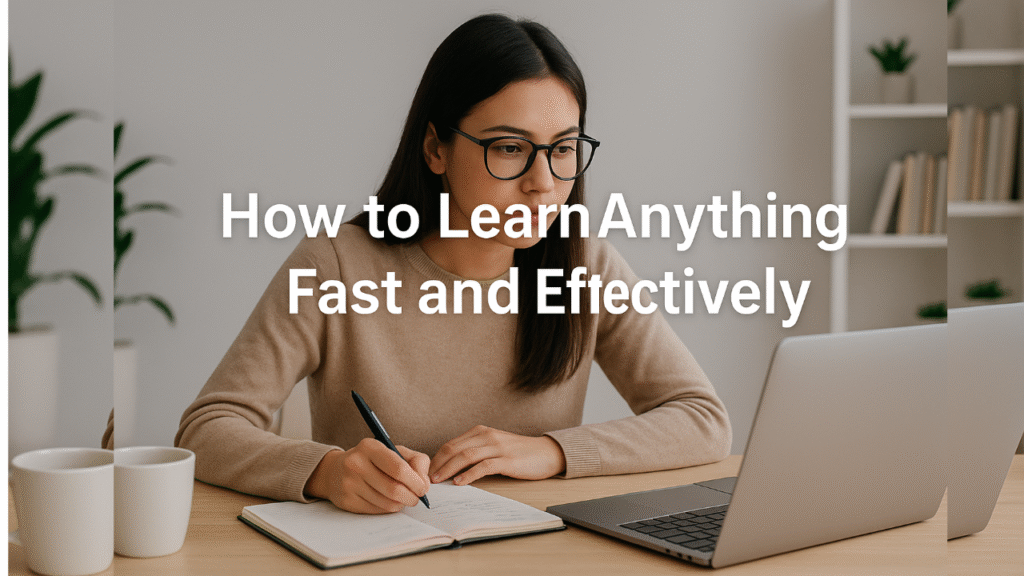
How to Learn Anything Fast and Effectively: The Ultimate Guide
One of the most potent abilities you can cultivate is the capacity to learn anything fast and efficiently. Being able to learn anything gives you an advantage in life, whether it’s picking up a hobby like playing the guitar, learning a new language, or developing your professional abilities.
The good news? Learning involves strategy, mindset, and consistency in addition to talent. You can accelerate your progress and improve your ability to retain information if you take the proper approach.
Learning strategies, accelerated learning methods, study advice, and real-world examples are all included in this guide to help you pick up new skills more quickly than you ever imagined.
Why It’s Important to Learn Anything Fast and Effectively in the Modern World
The information age is upon us. Industries are changing overnight, technology is developing quickly, and the people who can adapt the quickest will have the best opportunities. You won’t ever feel behind if you know how to make learning better.
Among the advantages of learning quickly are:
- Career advancement: Keep up with the latest developments in your field by adjusting to new tools and techniques fast.
- Personal development: Show yourself that you are capable of taking on new challenges to boost your confidence.
- Time efficiency: Use efficient techniques to complete more tasks in less time.
- Resilience: Being able to learn allows you to adjust to any circumstance.
The Mentality Shift: Have faith in your ability to learn anything

It’s important to have the correct mindset before beginning any techniques. Because they believe they are “too old” or “not smart enough,” many people give up on their education. The reality? According to research, the brain is neuroplastic, meaning it can adapt and create new connections at any age.
Fundamental idea: Intelligence is not fixed. You can learn anything if you put in the work and use the appropriate techniques.
Real-world illustration:
- Before creating the light bulb, Thomas Edison had thousands of failures. He had perseverance and successful experimentation, not a lack of intelligence.
Step 1: Define Your “Why”
Learning is fueled by motivation. Consider this:
- Why am I interested in learning this skill?
- What will it enable me to accomplish?
- How will mastering it enhance my life?
Your “why” might be to improve your career and communicate confidently, for instance, if you’re learning public speaking. Even in the face of difficulties, having a clear purpose helps you stay focused.
Step 2: Break Down the Skill
It can be overwhelming to try to learn too much at once. Use deconstruction instead:

- Divide the skill into manageable chunks.
- Start by concentrating on the most important components.
For instance, learning dozens of chords is not the best way to begin learning the guitar. Start with just a few strumming patterns and the three standard chords (C, G, and D). You’ll play songs more quickly and maintain your motivation in this way.
Step 3: Use the 80/20 Rule (Pareto Principle)
Not all education is created equal. According to the 80/20 rule, 80% of the outcomes are achieved with 20% of the effort.
What 20% of this skill will allow me to advance the quickest?
For instance:
- Learning a language: Concentrate on the 500 most frequently used words.
- Cooking → Learn 5–7 fundamental recipes and methods.
- Coding → Before delving into frameworks, learn fundamental ideas like loops, functions, and conditionals.
Step 4: Active Learning Beats Passive Learning
Although they are passive, reading and watching videos have their uses. Applying knowledge is where real learning occurs.

Try these methods for active learning:
- Test yourself to improve your recall skills rather than going over your notes again.
- Teach others: Concepts are easier to remember when explained.
- Practical experience: Put what you’re learning into practice right away.
For instance, don’t merely read about camera settings if you’re learning photography. Step outside, take pictures, and play with the lighting.
Step 5:Make Use of Accelerated Learning Strategies
You can learn more quickly by using the following tried-and-true accelerated learning strategies:
Interspersed Repetition
- Review the content more frequently—every day, every three days, every week, etc.
- This is made simple by programs like Quizlet and Anki.
Mental Models & Visualization
- To help you remember ideas, visualize them.
Example: To help you remember how the heart works, picture it as a water pump that forces blood through pipes.
Chunking
- Sort related information into manageable chunks.
- For instance, remember the numbers in chunks (349-871-6520) rather than memorizing 10 random digits (3498716520).
The Feynman Method
- Put your learnings in plain writing.
- Go back and review until you can articulate it clearly if you have trouble.
Step 6: Make Your Environment Better
You may be surprised to learn how much your surroundings impact your ability to concentrate.
- Eliminate distractions by turning off alerts and putting your phone away.
- Establish a learning space: A specific location tells your brain it’s time to concentrate.
- Employ background aids: White noise or instrumental music may help some people learn more effectively.
For instance, students who study in peaceful libraries tend to remember more than those who don’t
Step 7: Apply the Rule of Deep Work
Productivity is destroyed by multitasking. Schedule in-depth work sessions instead:
- For 60 to 90 minutes, give one task your whole attention.
- After that, take quick breaks to refuel.
Intensity is not as effective as consistency. Dispersed efforts over several days are preferable to even one concentrated hour per day.
Step 8: Learn From the Best
Instead of starting from scratch, take inspiration from those who have already mastered the technique.
- Read books written by professionals.
- Enroll in professional online courses.
- Adhere to role models or mentors.
For instance, instead of watching random YouTube videos, study successful business owners if you want to learn about entrepreneurship.
Step 9: Track Progress and Adjust
Measured progress leads to improvement. Maintain a record of your educational progress:
- Establish goals, such as “I’ll learn 200 new words in 30 days.”
- Every week, consider what went well. What didn’t work?
- As necessary, modify your tactics.
Real-world example: To get better, marathon runners monitor their pace and distance. In the same manner, you can monitor your learning objectives.
Step 10: Remain Patient and Consistent
The most important tip for learning anything is straightforward: Never give up.
- Little daily routines add up.
- Push through plateaus; they’re normal.
- Enjoy little victories along the way.
Comparing learning to compound interest, the more consistent you are, the bigger the long-term reward will be.
Easy Study Techniques to Improve Learning
Here are some more study pointers to help you get better results more quickly:
- Employ the Pomodoro technique (25 minutes of concentrated work, 5 minutes of rest).
- After every session, write summaries.
- Make connections between new and existing knowledge.
- After reaching milestones, treat yourself.
Real-Life Examples of Fast Learning
- Elon Musk is renowned for being an expert in difficult domains like business, artificial intelligence, and rocket science. What’s his secret? applying first-principles thinking and reading widely.
- Tim Ferriss, the author of The 4-Hour Chef, is well-known for breaking down difficult skills, such as martial arts and language acquisition, into smaller, more manageable parts.
- Polyglots: Individuals who speak ten or more languages frequently apply the 80/20 rule, emphasizing high-frequency words and consistent practice.
Common Mistakes That Slow Learning
- Attempting to be flawless right away: → Put more emphasis on progress than perfection.
- Information overload: Apply what you learn; less is more.
- Not doing regular reviews: n the absence of spaced repetition, you will quickly forget.
- Making comparisons with other people: Your path is distinct; pay attention to your speed.
Conclusion: You Can Learn Anything
Anyone who applies the proper mindset and techniques can learn anything quickly and efficiently; it’s not just a select few “gifted” individuals.

You can reach your full potential by establishing your “why,” segmenting your skills, utilizing active learning, implementing accelerated learning strategies, and maintaining consistency.
Don’t just read this—choose one skill you’ve always wanted to learn. Apply the steps in this guide starting today. In just a few weeks, you’ll be amazed at how quickly you progress.
Remember, the question isn’t “Can I learn this?”—it’s “How can I learn this effectively?”




